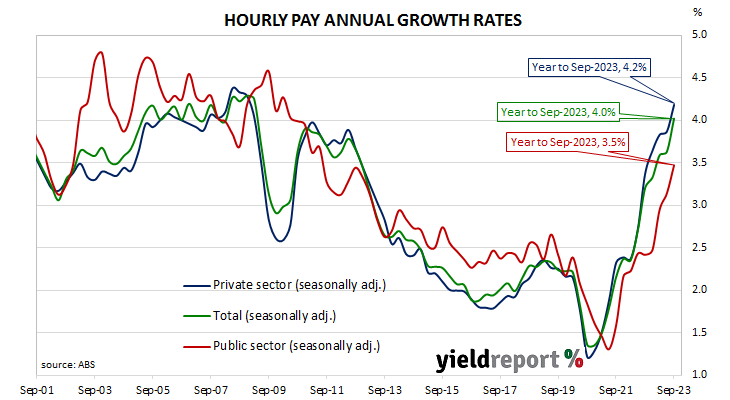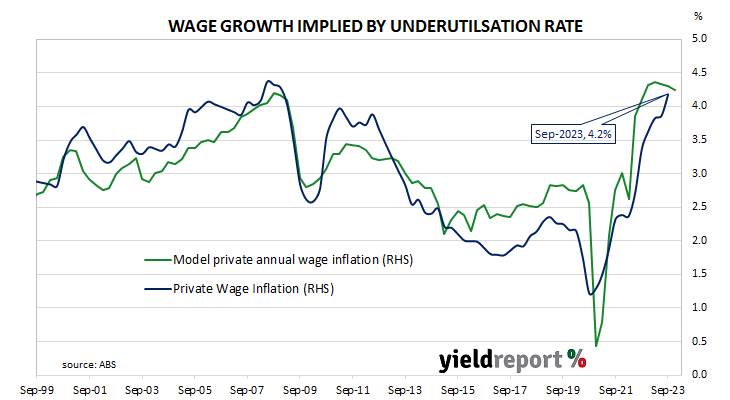Summary: September quarter WPI up 1.3%, in line with expectations; annual growth rate rises from 3.9% to 4.0%; Westpac: pace of growth from individual wage bargaining appears to have peaked; MSA signs of wage expectations still rising somewhat, despite modestly looser labour market; private sector wages up 4.2% over year, public sector up 3.5%; September underutilisation rate may imply plateau for wage growth in short-term.
After unemployment increased and wage growth slowed during the GFC, a resources investment boom prompted a temporary recovery back to nearly 4% per annum. However, from mid-2013 through to the September quarter of 2016, the pace of wage increases slowed, until mid-2017 when it began to slowly creep upwards. After remaining fairly stable at around 2.2% per annum from September 2018 to March 2020, the growth rate slowed significantly in the June and September quarters of 2020. Growth rates then accelerated over the next three years.
According to the latest Wage Price Index (WPI) figures published by the Australian Bureau of Statistics (ABS), hourly wages grew by 1.3% in the September quarter. The result was in line with expectations but higher than the June quarter’s 0.9% increase after it was revised up from 0.8%. On an annual basis, the growth rate accelerated from 3.9% after revisions to 4.0%.
“There was the boost from the minimum wage, showing up in award wages, as well as CPI Indexation…but the pace of growth from individual wage bargaining appears to have peaked,” said Westpac senior economist Justin Smirk.
Domestic Treasury bond yields fell substantially on the day, following heavy falls of US Treasury yields overnight. By the close of business, the 3-year ACGB yield had lost 12bps to 4.18%, the 10-year yield had shed 14bps to 4.54% while the 20-year yield finished 10bps lower at 4.87%.
In the cash futures market, expectations regarding further rate rises softened. At the end of the day, contracts implied the cash rate would remain close to the current rate of 4.32% and average 4.325% through December and 4.39% in February. May 2024 contracts implied a 4.44% average cash rate while August 2024 contracts implied 4.405%, 9bps more than the current rate.
“While the quarterly increase was primarily driven by the award wage increase, signs of wage expectations are still rising somewhat, despite a modestly looser labour market,” said Morgan Stanley Australia economist Chris Read. “[W}e expect wage growth to rise further, peaking at 4.2% next year.”
Wages in the private and public sectors grew by 1.4% and 0.9% respectively in the quarter. Over the past 12 months, wages in the private sector increased by 4.2% while public sector wages increased by 3.5%. Annual wage growth in the two sectors had been at 3.9% and 3.1% respectively in the June quarter.
The “underutilisation rate” is simply the sum of the unemployment and underemployment rates as per ABS monthly statistics. It has a good correlation with private wage growth two quarters in the future and thus it is useful as a leading indicator. However, differences can open up from time to time. September’s underutilisation rate suggests private wage growth may begin to plateau in the short-term.
Each quarter the ABS surveys around 3,000 private and public enterprises regarding a sample of jobs in each workplace to measure changes in the price of labour across 18,000 jobs. The results are used to construct the Wage Price Index in a manner similar to the construction of the Consumer Price Index (CPI). Changes in the WPI over time provide a measure of changes in wages and salaries, independently of the type or quantity of work.



